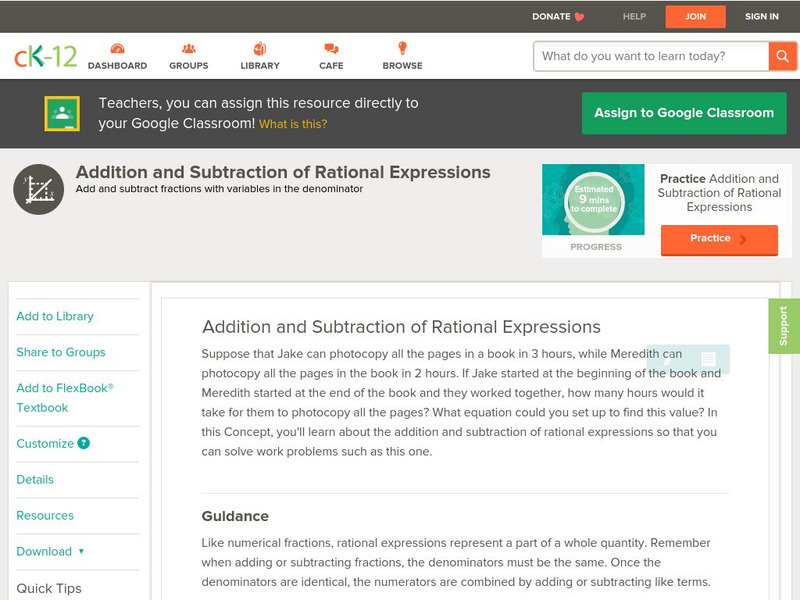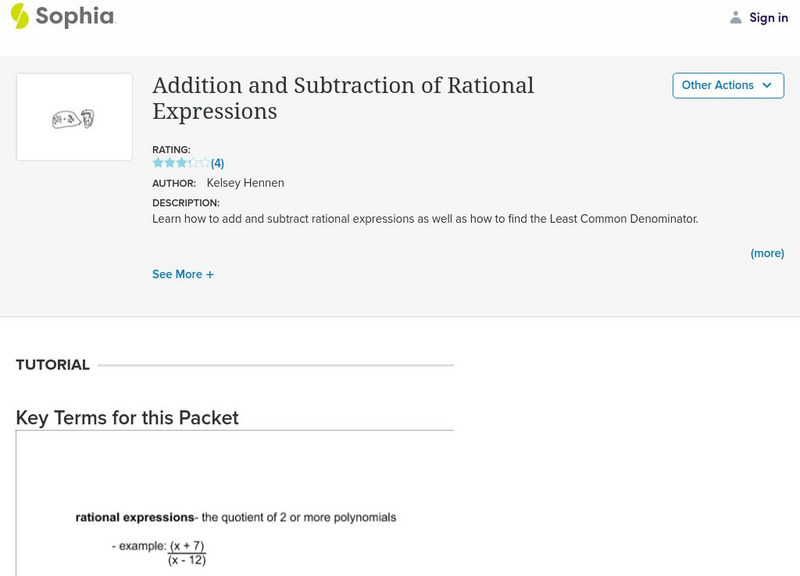Hi, what do you want to do?
EngageNY
Complex Numbers and Transformations
Your learners combine their knowledge of real and imaginary numbers and matrices in an activity containing thirty lessons, two assessments (mid-module and end module), and their corresponding rubrics. Centered on complex numbers and...
Inside Mathematics
Hexagons
Scholars find a pattern from a geometric sequence and write the formula for extending it. The worksheet includes a table to complete plus four analysis questions. It concludes with instructional implications for the teacher.
West Contra Costa Unified School District
Divisibility Rules Justified
How do you know if a number is divisible? Instructors first prove the divisibility rules for three and four and then class members use this modeling to prove given divisibility rules for eight and nine either individually or in...
Curated OER
Is That Your Final Answer?
This unit on integers includes a pre-test, a post-test, four spreadsheets, and links to an interactive web-site to support the learning of integer operations. Access to computers and the Internet are imperative to this unit. The lessons...
Virginia Department of Education
Balanced
Bring balance to your lesson plans with an activity that asks individuals to solve one-step linear equations with inverse operations. Balance scales help learners understand the concept of isolating the variable.
Curated OER
Solving Linear Equations
Use this worksheet for practice or review solving linear equations in one variable. Problems range from multiple-step problems involving parentheses and combining like terms, to word problems, to equations with no solution or infinitely...
Curated OER
Operations on Functions
In this operations and functions worksheet, learners add, subtract, multiply, and divide functions. This one-page worksheet contains 18 multi-step problems.
Curated OER
Properties of Numbers
In this algebra worksheet , students apply the properties of numbers to answer problems written in a certain way, The answer must make the property a true statement. There are 32 questions with an answer key.
Curated OER
A McTrip Back In Time
Students pretend they are time-travellers and travel back to 1954 to a McDonald's Restaurant to see how prices have changed. They need to add and subtract money with regrouping.
Curated OER
Sloping and Intersecting a Linear Function
Young scholars examine and discuss typical linear equations, and the difference between a linear and nonlinear equation. They observe examples of linear equations and complete a worksheet.
Curated OER
Fractions in the Kitchen
Seventh graders use the World Wide Web for research, identify fractions found in everyday life by finding a recipe that uses fractions.
Curated OER
Company is Coming
Students find a recipe for pancakes on the web then figure out how to half the recipe then figure how to make 3/4 of the pancakes.
Curated OER
Solving One Step Equations
Students observe and demonstrate the step-by-step process for solving one-step equations. They view a teacher-created PowerPoint presentation, solve one-step equations, and in small groups create a PowerPoint presentation.
Curated OER
One Step Equations
In this solving equations worksheet, students solve 11 one step equations. Students subtract a constant to isolate the variable.
Curated OER
How Many Bears in the Forest?
Third graders model the tag and recapture of bears and use proportions to estimate the population of the bears in their forest. This is a statistical sampling method used by scientists and naturalists to determine population numbers.
Texas A&M University
Wtamu Virtual Math Lab: College Algebra: Adding & Sub. Rational Expressions
Rational expressions have never been so easy! Use this site to learn how to add and subtract them with ease and confidence. And common denominators? No Problem! Great practice problems are included to see how much you've learned.
CK-12 Foundation
Ck 12: Algebra: Applications of Rational Expressions
[Free Registration/Login may be required to access all resource tools.] In this lesson students solve applications that involve adding and subtracting rational expressions. Students watch a video tutorial, explore guided notes and...
Purple Math
Purplemath: Adding & Subtracting Rational Expressions: Introduction
Finding common denominators is no problem with Purplemath. Use this lesson to learn how to add and subtract rational expressions with these great examples.
Varsity Tutors
Varsity Tutors: Hotmath: Practice Problems: Adding and Subtracting Rational Expressions
Sixteen problems present a variety of practice adding and subtracting rational expressions. They are given with each step to the solution cleverly revealed one at a time. You can work each step of the problem then click the "View...
CK-12 Foundation
Ck 12: Algebra: Addition and Subtraction of Rational Expressions
Learn how to add and subtract rational expressions.
CK-12 Foundation
Ck 12: Algebra: Addition and Subtraction of Rational Expressions
This lesson covers adding and subtracting rational expressions when the denominators are the same.
Sophia Learning
Sophia: Addition and Subtraction of Rational Expressions
Use the examples to find the least common denominator in order to add and subtract rational expressions.
CK-12 Foundation
Ck 12: Algebra: Addition and Subtraction of Rational Expressions
[Free Registration/Login may be required to access all resource tools.] Learn how to add and subtract rational expressions.
CK-12 Foundation
Ck 12: Algebra: Addition and Subtraction of Rational Expressions
[Free Registration/Login may be required to access all resource tools.] Add and subtract rational expressions with the same denominator and different denominators.




























